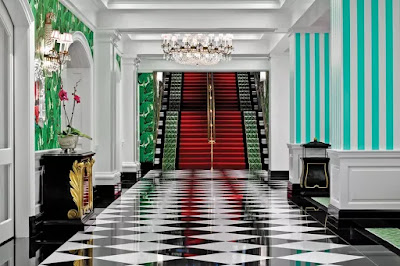Post modernism is the period of artistic and architectural development from the 1960's onward. The developments in the 1970's, 80's and 90's challenged the precepts of modernism. In architecture, elements of classicism and of other historical traditions were integrated in buildings. During this time there were many revivalist movements, and a revolt against the strict rationality of Modernism. The hopes of the optimistic modernist movement were dashed because of the worldwide energy crisis. This crisis began when members of the Organisation of Arab Petroleum Exporting Countries proclaimed an oil embargo against nations that they believed were supporting Israel during the Yom Kippur War, which included the US. In the 1980's, as the economy started to improve, we see a self-orientated consumer culture, and people were "grabbing" all that they could from the past.
In the 1990's, there is a rise of the environmentalists. They saw that the amount of production and consumerism was having a negative impact on the earth. Recycling and promoting the DIY spirit became ways to deal with these environmental issues. I appreciate this aspect of post modernism the most because I think it is important for us to be good stewards if the earth God created and put us in charge of. Also, I enjoy DIY projects and creating beauty out of recycled materials. Someone who inspires me to do more DIY projects is Ben Uyeda at HomeMade Modern. He was an architect, who gave up architecture so he could design and share DIY tutorials that would help people around the globe use materials they have available to them efficiently.
The 1990's was also the period of several technological advancements, which had an impact on design; including the creation of portable telephones, and the creation of personal computers. This increased cross cultural communication, making people more aware of the things going on around the world. The Memphsis Group consisted of designers and architects who came together cross-culturally to establish the post modern design style, which is inspired by Pop Art and Art Deco. Personal computers transformed the design of office spaces and furniture because there was now a diversity of working styles. Injection-molded manufacturing of plastics allowed for more sculptural furniture with bight colors.
Deconstructionism was the design style of the late 1980's. This design idea was to create a whole by moving around the standard parts and pieces of a building. This design style entered the mainstream in the 1990's, when post modernism as an obvious design form was in decline.
Historical Examples:
 |
| The Tawaraya (boxing ring) bed, work of the Memphis group. |
 |
| City of Culture Galicia, Spain, by Peter Eisenman |
 |
| Chair designed by the Brothers Campana |
Current Applications:
 |
| Apartment in Budapest, Hungary, by Margeza |
 |
| David Bowie's display of Memphis furniture in this collection of postmodern art. |
One Step Further...
Robert Charles Venturi is an American architect, born in 1925 in Philadelphia, Pennsylvania. He was one of the architects who proposed alternatives to the functionalist mainstream American architectural design of the 20th century. He studied at the Princeton University School of Architecture in New Jersey. He partnered with Denise Scott Brown, and their partnership lead the way to the post modernism movement.
Venturi wrote two books that were influential to the movement. One is Complexity and Contradiction in Architecture (1966). Unlike the Modernists, he embrace Historical precedents and ornamentations. He cleverly said that "Less is a bore," in contradiction to Mies van der Rohe's concept of "Less is more." In the second book, Learning From Las Vegas (1972), he studied the urban architectural forms in Las Vegas, and concluded that ornamentation is needed in urban architectural design because it provides "meaning" to urban architecture. The Vanna Venturi House (pictured below) is one of his famous works based on his theory.









Eunice,
ReplyDeleteI enjoyed how in your summary you mentioned how much recycling and DIY has changed design today. I am a very big advocate in our environmental stewardship and believe as designers, we are called to take care of our source of materials. I also really enjoyed seeing your current applications of this movement and they are very tastefully designed. I did not think that was possible especially with the Memphis Movement.